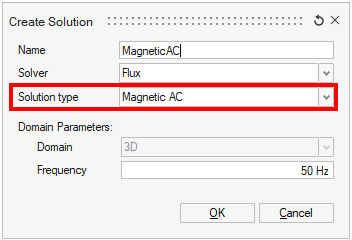AC Magnetic solution
![]()
Presentation
The AC Magnetic solution allows the study of devices in the "harmonic" state (sinusoidal steady state) for a given frequency.
The complex image of Maxwell's equations considers all physical quantities are sinusoidally time-varying for a given frequency. The magnetic field is connected with the presence of the time varying electric currents, compulsory sinusoidal. (Magnet type regions are forbidden).
This application takes into account the currents induced in the conducting regions (eddy currents). It also considers the skin effects* and the proximity effects in the conducting regions.
Solution dialog box
The AC Magnetic solution is currently available only for the 3D domain.
Important results
The results obtained with AC Magnetic solutions are:
- the same as for a Magnetostatic application
- the induced currents and the power losses by Joule effect in eddy current regions
The computed physical quantities are sinusoidally time-varying (for a given frequency). It is expressed using their complex images.
Starting from the time dependent quantities, we could compute global, time independent quantities, such as inductance…
Use
The AC Magnetic solution can be used to model devices in different domains such as: induction heating, electromagnetic compatibility in general and electromagnetic screening in particular (e.g. transformers tanks), rotating machines in steady state…
The AC Magnetic solution can be of the field-circuit coupling type, for the study of rotating machines, of transformers, etc. in steady state, when the numerical model must take into account the electric circuits associated to the device. This application cannot be used with a kinematics coupling.
Restrictions related to complex notation
Attention, in the context of an AC Magnetic solution, all the physical quantities are expressed using their complex notations.
The representation by complex notations is valid on the following hypotheses:
- all the materials are linear
- the sources are sinusoidal (the regions containing magnets are forbidden).
Nevertheless, many devices can be studied taking into consideration these hypotheses. Moreover, the utilization of complex numbers can be extended in some particular cases as in the case presented in the next block.
Accepted approximations
The utilization of a complex numbers representation can be extended in some cases:
- First, when taking into account the materials with nonlinear characteristics. Although in this case the quantities are not sinusoidal any longer, a method based on an energetic equivalence allows one to define a B(H) relation called “equivalent”, which takes into account the fact that the quantities are sinusoidal time-varying. So, the result, which is an approximation, since it is expressed under a sinusoidal form, will still give a relatively precise view of the results.
- Moreover, in the case of linear materials you should note that in the case of non-sinusoidal field sources, the problem could be treated as the superposition of many harmonic problems using decomposition in Fourier series. Some authors extend this possibility to the case of nonlinear materials.
Example type
As for Transient Magnetic applications, We can distinguish two typical examples that correspond schematically to two families of physical phenomena:
- the magnetic physical phenomena
- the electric conducting physical phenomena
These two typical examples are depicted in the next section. An important difference with respect to the Transient Magnetic applications is the absence of magnets.
Typical example (1)
A first typical example of a problem treated as an AC Magnetic application is presented in the figure below. It concerns a typical example without coupling to an external electric circuit.
| air or vacuum |
|
|
|
magnetic environment (non conducting) |
||
|
conducting environment (non magnetic) negligible EC * |
||
|
|
conducting environment (magnetic or not) with possible EC* |
In the previous typical example (1), the conducting medium called “passive”.
() is a medium where the current is of the
induced type. We can also call it the conductor “supplied” only by
induction.
Typical example (2)
A second typical example of a problem treated as an AC Magnetic application is presented in the figure below. It is an example with coupling to an external electric circuit .
| air or vacuum | ||
|
magnetic media (non conducting) |
||
|
conducting media (non magnetic) negligible EC * |
||
|
|
conducting media (magnetic or not) with possible EC* |
In the previous typical example (2), the conducting medium can be a medium:
- “passive”: as in the previous example
- “active”: the conductor is supplied by an external sinusoidal AC voltage or current source. It can also be “supplied” by induction.